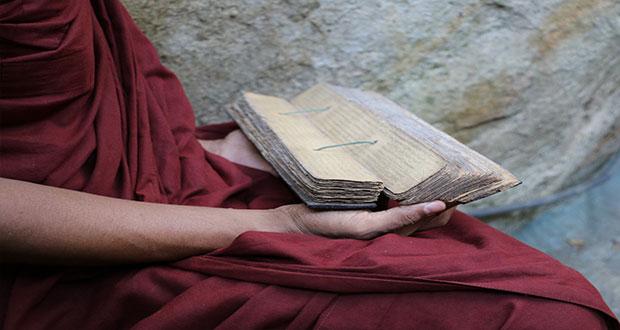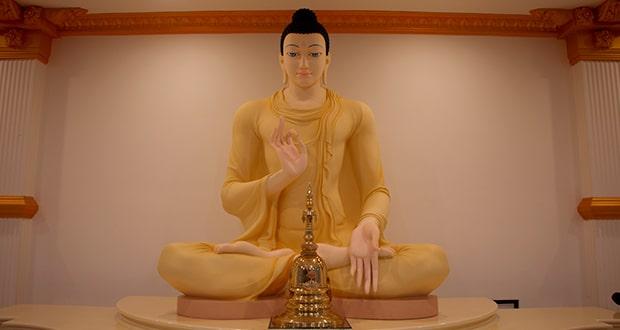There are unbelievable kinds of diseases in the world today. Starting from cold and flu to terminal illnesses, there probably isn’t anyone in the world who has not suffered from an affliction. Also, it is most likely that everyone in the world has a relative who had died or diagnosed with a terminal illness. However, if there is any exceptional person who has never been sick, that person cannot escape from aging and the feebleness that comes with old-age. So, what happens when we get sick? Our body hurts, it weakens and makes us inactive, with that our mind too gets disturbed, sad, weak and vulnerable. This explains that we suffer from two types of pains; bodily and mentally. However, the Supreme teachings of the most compassionate Buddha tell us how to keep our mind from being weak and vulnerable when the body is afflicted.
This amazing Dhamma talk is found in the Samyutta Nikaya of the Pali Canon and it is called Nakulapitu Sutta. On one occasion, the Supreme Buddha was residing in Bhesekala Grove. One day the householder Nakulapitu went to see the Buddha and on arrival paid homage to the exalted One, sat on one side and said, “Lord, I am a feeble old man, aged, advanced in years, having come to the last stage of life. I am afflicted in body and ailing with every moment. Hardly I get any time to see the Blessed One & the monks who nourish the heart. May the Blessed One teach me, may the Blessed One instruct me, for my long-term benefit and happiness.”
Then the Supreme Buddha said “Dear householder, what you say is absolutely correct. This body is subject to sickness. This body which is covered with a skin is fragile like an egg shell. If anyone, having this body, claims to be truly healthy, it is only due to his foolishness. Therefore, dear householder train yourself thus, ‘may this body, which is subjected to affliction be afflicted, but I will not let my mind be afflicted.”
Having heard this Dhamma, householder Nakulapita was extremely happy. Agreeing to these words he venerated the Fortunate One, rose from his seat, and went to see the venerable Sariputta, the chief disciple of the Buddha. Then venerable Sariputta asked householder Nakulapitu the reason why he looked so calm and happy with his complexion radiant. Venerable Sariputta asked whether householder Nakulapitu had the opportunity to listen to Dhamma talk from the Supreme Buddha Himself. Householder Nakulaptiu replied, that there is no other reason for him to be so happy and in fact told venerable Sariputta the Dhamma he learnt from the Supreme Buddha. At that time, venerable Sariputta asked;
“But why didn’t it occur for you to ask the Supreme Buddha: ‘how does one who is afflicted in the body become afflicted in mind too? And how does one who is afflicted in the body become unafflicted in mind?”
At that time, the householder Nakulapita kindly invited venerable Sariputta to explain what the Supreme Buddha said, in detail. Accepting that, venerable Sariputta first explained how one, who is afflicted in the body becomes weak and vulnerable in mind.
“There, an uninstructed, common person — who has no regard for noble ones, is not well-versed or disciplined in Dhamma; assumes form (the body) to be the self, or the self is made up of form, or form is in the self, or the self is in form. He is seized with the idea that ‘I am form’ or ‘form is mine.’ As he is seized with these ideas, when form changes and alters, he falls into sorrow, lamentation, pain, distress, and despair over its change and alteration.”
What is meant by Form? Form is the collection of the four great elements. And what is the nature of the four great elements? Impermanence is the nature of the four great elements. Constant change is the nature of the four great elements. Therefore, form – the body – is impermanent and it changes constantly. Affliction in the body is only a change in one or all four elements, which is the nature of those elements and we have no control over this. When a person is seized with the idea that ‘form is mine’ then he laments, becomes weak and vulnerable in mind when the body becomes afflicted.
Venerable Sariputta continues; “He assumes feeling to be the self, or the self is made up of feeling, or feeling is in the self, or the self is in feeling. He is seized with the idea that ‘I am feeling’ or ‘Feeling is mine.’ As he is seized with these ideas, when his feeling changes and alters, he falls into sorrow, lamentation, pain, distress, and despair over its change and alteration.”
“He assumes perception to be the self, or the self is made up with perception, or perception is in the self, or the self is in perception. He is seized with the idea that ‘I am perception’ or ‘Perception is mine.’ As he is seized with these ideas, when his perception changes and alters, he falls into sorrow, lamentation, pain, distress, and despair over its change and alteration.
He assumes (mental) fabrications to be the self, or the self is made up with fabrications, or fabrications are in the self, or the self is in fabrications. He is seized with the idea that ‘I am fabrications’ or ‘Fabrications are mine.’ As he is seized with these ideas, when his fabrications change and alter, he falls into sorrow, lamentation, pain, distress, and despair over their change and alteration.
How does feeling, perception and fabrication arise? Feeling, perception and fabrication arise due to contact – Phassa. Phassa is the process of three things coming together- ‘Thinnan sangathi passo’; sense faculty, object and the consciousness. For example when the eye, visual object and eye consciousness come together at the eye, Feeling, perception and fabrication arises. The three things that are involved in the arising of contact (phassa) are impermanent. Therefore contact is impermanent. Then can the feeling, perception and fabrication be permanent? Because they arise when the contact arises. They arise due to a cause. They change when the cause changes. And when the cause ceases, they cease. Therefore, when someone has the belief that ‘feelings are mine’, ‘perception is mine’ or ‘mental fabrications are mine’ then when they change he falls into grief, sorrow and becomes ill in mind.”
Venerable Sariputta explains further; “He assumes consciousness to be the self, or the self is made up with consciousness, or consciousness as in the self, or the self as in consciousness. He is seized with the idea that ‘I am consciousness’ or ‘Consciousness is mine.’ As he is convinced by this belief, when his consciousness changes and alters, he falls into sorrow, lamentation, pain, distress, and despair over its change and alteration.”
What causes the consciousness to arise? According to the noble Dhamma, the consciousness arises due to Nama-Rupa – Name & Form. What constitutes Nama? Vedana–feeling, Sanna – perception, Cetana – mental fabrications, – Phassa – contact and Manasikara – alertness of the mind. And Rupa is the collection of four great elements –patavi, apo, thejo, wayo. When Name & Form change, the consciousness changes, and when Name & Form cease, consciousness ceases. That means consciousness arises due to a cause and it cannot be held as ‘me’ or ‘mine’. But when someone is seized with the idea that ‘consciousness is mine’ then when it changes he laments, grieves and falls mentally sick.
Venerable Sariputta explains; “This, householder, is how one is afflicted in body and afflicted in mind.
And how is one afflicted in body but unafflicted in mind? There, a well-instructed disciple of the noble ones — who has regard for noble ones, is well-versed and disciplined in their Dhamma, does not assume form to be the self, or the self is made up of form, or form is in the self, or the self is in form. He is not seized with the idea that ‘I am form’ or ‘Form is mine.’ As he is not convinced of this, when form changes and alters, he does not fall into sorrow, lamentation, pain, distress, or despair over its change and alteration.
He does not assume feeling to be the self…
He does not assume perception to be the self…
He does not assume fabrications to be the self…
He does not assume consciousness to be the self, or that the self is made up of consciousness, or consciousness is in the self, or the self is in consciousness. He is not seized with the idea that ‘I am consciousness’ or ‘Consciousness is mine.’ As he is not seized with these ideas, when his consciousness changes and alters, he does not fall into sorrow, lamentation, pain, distress, or despair over its change and alteration.
This, householder, is how one is afflicted in body but unafflicted in mind.”
How does one achieve this mental freedom when faced with aging and sickness? A noble disciple of the supreme Buddha listens and learns that these Five Aggregates of Clinging (pancha upadanas kandha); form, feeling, perception, fabrications and consciousness – exist due to causes, and that they cannot be held on to as ‘me’ or ‘mine’. He knows that when the cause changes the effect changes. He also sees the impermanent nature of the Five Aggregates of Clinging. He is the one who can keep his mind from being weak and vulnerable when the body is afflicted. After listening to the life enlightening words of the chief disciple of the Buddha, venerable Sariputta, the householder Nakulapita was delighted and determined to practice these blissful words.
MAHAMEGHA 2013 Nikini Issue
WWW.MAHAMEGHA.LK
By Prajapathi Jayawardene












Recent Comments